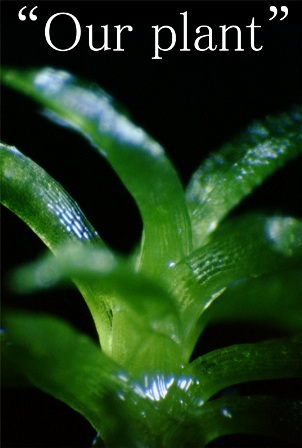FUJITA, TomomichiProfessor
We know that plants cannot move, but we don’t know why they chose such life style and how wonderful the style is for them? Once we look at plants carefully, we notice that they have a lot of astonishing tactics to survive, and we have to learn much more from them. We also know that plants are important for us as photosynthetic autotrophs that directly or indirectly nourish almost all other forms of life on earth.
As yet, however, we poorly understand how plants respond to their environment and how plants control their growth. Most likely plants and other multicellular organisms such as animals evolved separately, raising questions: what are critical differences in developmental mechanisms and how common features are shared between plants and animals? A fundamental difference between them is the presence of rigid cell walls and the absence of cell migration.
In this laboratory, our major goal is to understand how plants control their unique mode of growth and development at molecular and cellular levels and to understand how plants generate their divergent morphology during evolution. We mainly use the moss, Physcomitrella patens as a model plant, which is relatively new and advantageous for evo-devo research.
The following projects are currently emphasized: 1) Molecular mechanisms of how plant cells proliferate and differentiate. Cell polarity and asymmetric cell division are the key to this. 2) Molecular mechanism of cell cycle control, cell fate determination and transdifferentiation from a cell type to other cell types. 3) Molecular mechanisms of totipotency and regeneration in plants. 4) Evolution of body plan in plants from viewpoints of evolution of auxin and other hormone network. 5) Unveiling how environmental signals are integrated into developmental programs. Molecular dissection of abscisic acid signaling ought to be the key to the issue.

Currently, understanding of the plants becomes more and more important for human being and even for any life on earth.
Those who are interested in our projects and in the field of plant science, please feel free to contact me by e-mail. I always very welcome to discuss and work with highly-motivated students and researchers across national borders.
References
- Kitagawa, M. and Fujita, T. (2015) A model system for analyzing intercellular communication through plasmodesmata using moss protonemata and leaves. Journal of Plant Research, 128, 63-72.
- Banks, J.A., et al. (2011) The Selaginella Genome Identifies Genetic Changes Associated with the Evolution of Vascular Plants. Science, 332, 960-963.
- Fujita, T.,et al. (2008) Convergent evolution of shoots in land plants: lack of auxin polar transport in moss shoots. Evolution and Development, 10, 176-186.
- Fujita, T., et al. (2004) Gene tagging, gene- and enhancer-trap systems, and full-length cDNA overexpression in Physcomitrella patens. In New Frontiers in Bryology:Physiology, Molecular Biology & Functional Genomics, pp.111-132, Kluwer Academic Publishers, Netherlands.
- Syono, K. and Fujita, T. (1994) Habituation as a tumorous state that is interchangeable with a normal state in plant cells. In International Review of Cytology, 152, pp.265-299, Academic Press, California.
Website
Plant Evolutionary and Developmental Biology
Faculty
Faculty of Science
Department of Biological Sciences
Cell Structure and Function
Grad School
Graduate School of Life Science
Division of Life Science
Biosystems Science Course
Contact Information
Faculty of Science, Building #5 5-613
Email: tfujita ![[atmark]](https://www2.sci.hokudai.ac.jp/dept/bio/wp/wp-content/themes/sci-bio_2407/img/atmark.png) sci.hokudai.ac.jp
sci.hokudai.ac.jp
